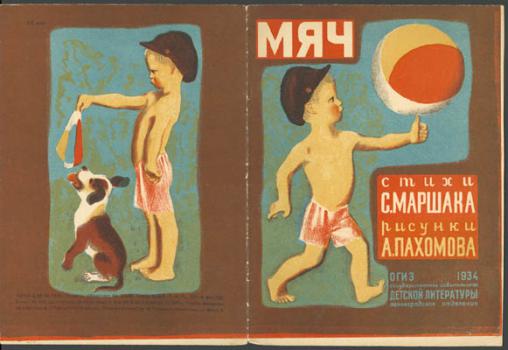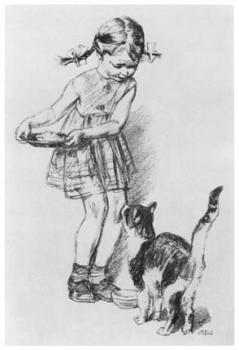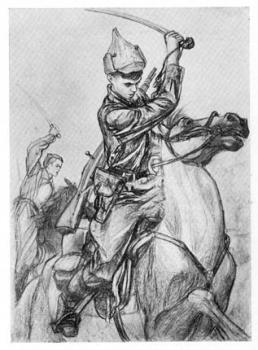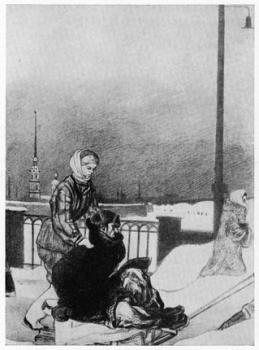Alexey Fedorovich Pakhomov. For the Centenary of His Birth
Natalia Melnikova
Alexey Fedorovich Pakhomov (1900-1973) — was a splendid graphic artist and master of lithography. His outstanding artistic gift was already evident in family portraits he created when a very young boy. He was much impressed by the cheap popular prints hung in his father's house in Vologda province. In 1915, at an urgent request of the art lover V. lu. Zubov, the young artist was sent to study at Baron Stieglitz's School for Engineering Design in Petrograd. There he was enraptured with plaster cast copying, and gradually gathered strength with Italian pencil and Indian ink.After the February Revolution several prominent masters like M. V. Dobuzhinsky, S. V. Chekhonin, V. I. Shukhaev were invited to teach in the School. They focused on drawing from life. Chekhonin's advice on making a "fair" arrangement in a single stroke played a great role for young Pakhomov's growing creative skills.
When the School was reorganized as VKhUTEMAS in 1919, the young artist studied with V. V. Lebedev, N. A. Tyrsa, A. E. Karev. Leaders of the Studios adopted French post-impressionistic experiences in a creative manner, shaping the arts in context of the new society. In 1921-23 they established the Association for New Trends in Art with The Four Arts and Artists' Circle groups which Pakhomov joined. His creative strivings at that time involved multiple trends, from Cubism and Sezannism in painting to Functionalism when, following the Industrial Arts motto, the artist went to work at a factory. However, with all his confusing ideas and tasks in art, Pakhomov also paid tribute to the approach employed by Lebedev whose illustrations of children's books and ROSTA Windows posters he regarded as superb creative achievements. It was from Lebedev that Pakhomov inherited his laconic imagery, clear-cut contours and expressive lines. Gradually, the artist moved from painting to drawing.
Since 1925 Pakhomov devoted himself to children's books, along with authors like V. V. Maykovsky, S. la. Marshak, A. L. Barto, E. L. Schwartz, and artists V. M. Konashevich, K. I. Rudakov and V. M. Ermolaeva. The children's theme was not at all accindental in his art: sketching from life, he often pictured children, capturing interesting graphic postures and movements.
In the mid-1920s the artist visited pioneer camps, including the Artek. Characteristic features of children's book, natural for the child's mind and eye, made special demands on the artist. Education if a new man in the context of emerging conceptions and ideas determined a new approach to book design.
First experiences with children were represented in his illustrations for works of Marshak, Schwartz, R. Kipling in the late 1920s. Pakhomov's style had much in common with contemporary avant-garde tendencies in art. The artist worked in silhouette, patching, almost inking in, portraying lights and darks in an icon-painting manner. The background was almost invariably indifferent. The master's favorite colors were red, yellow and brown.
In fact, Pakhomov, like many other artists of the time, employed an essentially innovatory approach to children's book illustration. Pictures in books and magazines in the 1910s differed from the ecstatic and refined imagery of the turn of the century. They were dynamic, vivid and contrasting. At the same time, they retained the comprehensive approach to book illustrating typical for the first decade of the century: integrative design involving the cover, illumination and lettering. The pictures were to "live" in the text rather than support it.Bold subject and color design was typical for Pakhomov's work in the 1930s. The half-naked women and sun-tanned teenagers on the beach contrasted the correct boys and girls painted by artists of Social Realism.
Lithographs provided the final innovatory stroke in his art — Pakhomov was soon transformed as a humble chronicler of Soviet reality.
Since the 1930s and 1940s Pakhomov illustrated books of N. A. Ostrovsky, I.S. Turgenev, N. A. Nekrasov, or Lenin tales in children's magazines Siskin and Hedgehog. The style of his work changed: the local patch and silhouette replaced with bright and dynamic line, and fine stroking. His "graphic painting" was replaced with "painting graphics".To attain a new goal in book design, Pakhomov chose the life-sketching technique, with rare use of color. He strove for personalization, drawing the viewer's attention to the facial expression and gestures of his characters. With linear drawing, the artist created images that appeared as charged with emotion and spontaneity but were devoid of psychological content. His illustrations for books of Maykovsky and Marshak in the late 1930s and early 1940s lack the previous clear perception of the environment and innovatory characters. Children in Pakhomov's works think and feel identically, despite the precise portraiture.
The Great Patriotic war 1941-1945 caught the artist in Leningrad besieged by the enemy. Along with a few graphic artists in the beleaguered city, Pakhomov proceeded with his creative work, producing a set of lithographs entitled Leningrad Besieged. However, while preliminary drawings are vivid and expressive, lithographs look dry and almost bombastic. The 1942-43 posters from the sketches are more harmonious.In the climate of postwar advance and public enthusiasm for reconstruction in Leningrad, Pakhomov produced the set of lithographs In Our City (1944-46). The good spirits and optimistic motivations are reflected in his sketches of the people, streets and buildings in the city. The plates gain characteristic dynamism with unusual perspectives and boldly foreshortened figures. The prestigious State Award for the sets stimulated further works demonstrating Soviet achievements.
Between the 1950s and 1970s, the final period in his life and work, Pakhomov deliberately chose plain everyday stories, avoiding big and complex tasks. He preferred women in collective farms, physicians or teachers engaged in routine tasks. Due to unbiased illustrative style and conventional artistic techniques, Pakhomov's later work seems similar to that of many other Soviet artists. However, the keen vision and neat arrangement betray a genuine master of his art. The children presented to us by Pakhomov are still affecting and natural. His illustration for works of S. V. Mikhalkov, V. A. Oseeva, L. N. Tolstoy in 1950-1970 demonstrate both fine vision and striking knowledge in child psychology. Books illustrated by Pakhomov served as the first life guides for several generations of children. The memorable characters of children's books introduced them to the world of prose and poetry of the Soviet period.Pakhomov's works from the Library's collections, shown at the exhibition, present his life story as a series of several important stages of the artistic development. The exhibition contains an outstanding display of posters and lithographs from the Print Department Collections, drawings from the Manuscript Department Holdings, books and periodicals from the Russian-language Book Collection and the Russian-language Collection of Periodicals.






